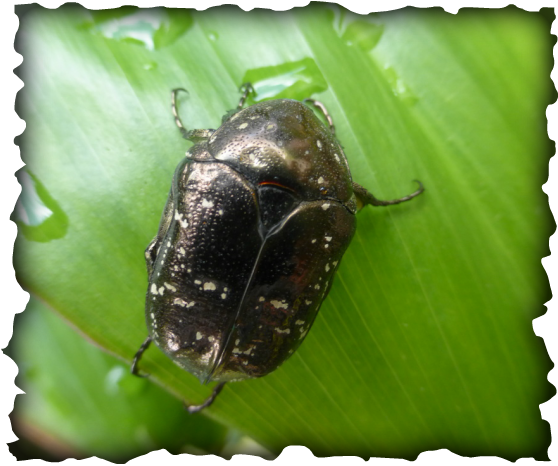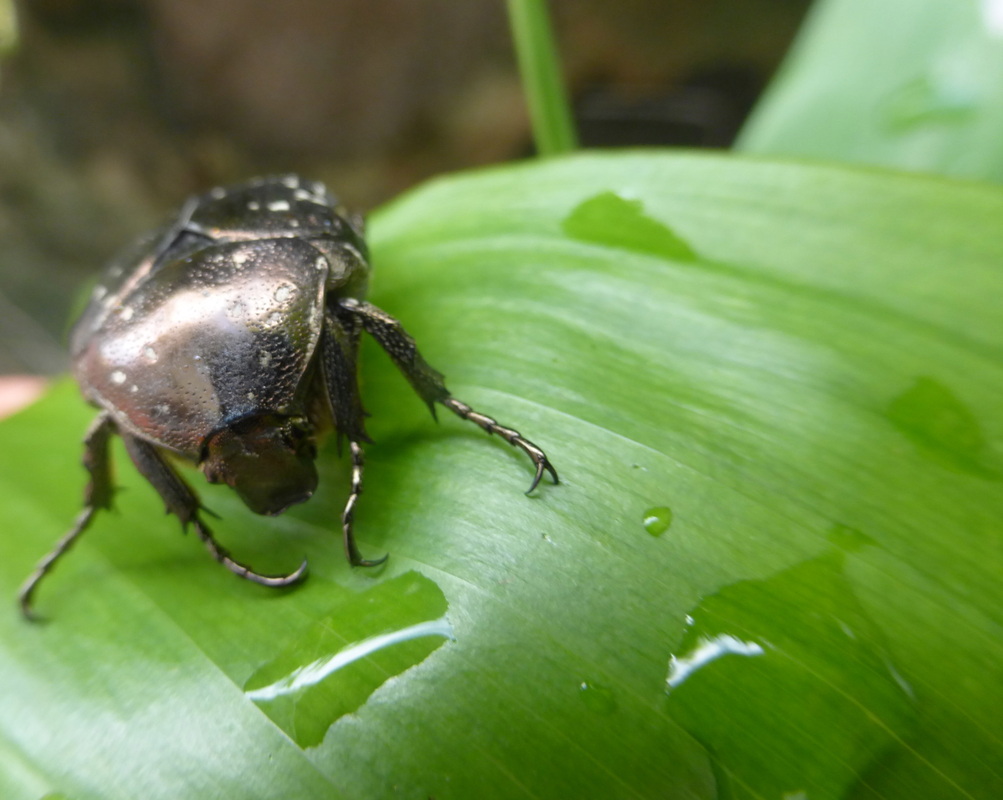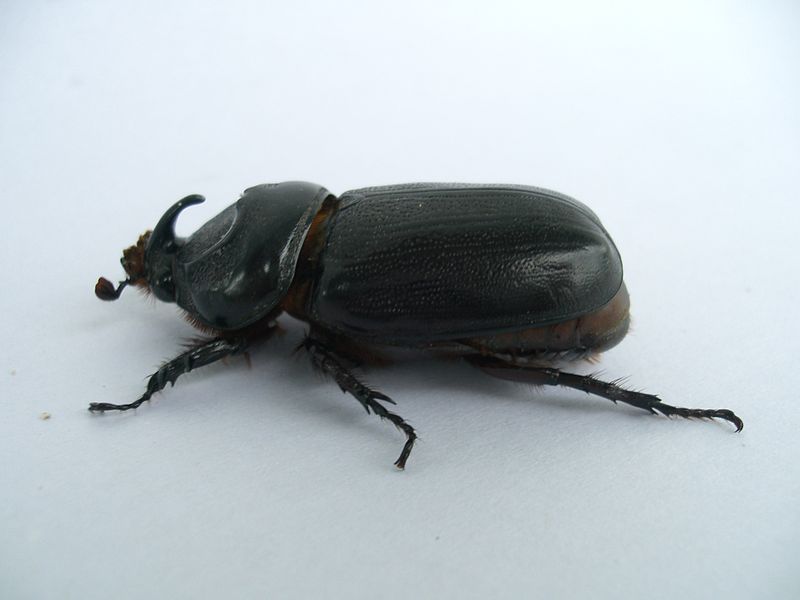Proteatia orientalis has been known on Oahu since 2002, and has since been identified on Maui, and just recently on the Big Island. Eggs are laid in the soil, where the grub, or larvae hatch and then pupate; as with all beetles, metamorphosis is complete, whereas true bugs undergo incomplete metamorphosis. The oriental flower beetle can be confused with the coconut rhinoceros beetle, Oryctes rhinoceros, a major pest of coconut palms that was first seen in Honolulu in December of 2013.
|
Hailing from China, Korea, and Japan, the oriental flower beetle, Proteatia orientalis, is a hefty beetle, about the size of my upper thumb. Its attractive bronzy metallic sheen is splotched with white markings, and gives a hint that it is in the family of Scarab beetles, many of which sport metallic colors. It also claims membership in the subfamily Cetoniinae, also known as the flower chafers, a group of diurnal beetles that feed on nectar, pollen, sap, and some, like are guy here, on damaged fruit. On Guam, where it is widespread, it has been known to feed on the flowers of papaya, coconut, betel nut, mango and corn, and may damage the flowers of these trees, resulting in fewer fruit. Proteatia orientalis has been known on Oahu since 2002, and has since been identified on Maui, and just recently on the Big Island. Eggs are laid in the soil, where the grub, or larvae hatch and then pupate; as with all beetles, metamorphosis is complete, whereas true bugs undergo incomplete metamorphosis. The oriental flower beetle can be confused with the coconut rhinoceros beetle, Oryctes rhinoceros, a major pest of coconut palms that was first seen in Honolulu in December of 2013.
52 Comments
4/3/2014 08:17:36 pm
Would like to find more information
Reply
Aunaturale
4/22/2014 06:32:04 am
While picking plumeria blossoms in downtown Honolulu this morning, I found several Oriental Flower beetles on the branches. I've lived here over sixty years, and this is the first time I've ever seen one.
Reply
Ed
5/13/2014 12:01:04 am
I found these beetles hanging out on my coconut tree flowers and tangerine tree. I believe they are damaging my coconut count.
Reply
Sam & Rebecca
11/13/2022 02:02:41 pm
I believe we have just experienced this with our cocos. Cocos are mis shaped oblong going brown prematurely and fall early. We will try Fruit Tree spray after bees go to bed. Any advice?
Reply
Beau
10/5/2023 02:14:03 pm
Sounds like you have mites
Meredith speicher
5/31/2014 08:10:59 am
My daughter found the oriental flower beetle. Waialua, Oahu
Reply
NA
6/3/2014 09:56:13 am
There is a swarm on my aunts mango tree in Nanakuli! My aunt was wondering why only half of the mango tree produced fruit. When I went to pic some mangos, the beetles were on each branch. This is the first time I have seen this beetle in Nanakuli. I thought the tree might be diseased but after searching online, the beetle matched what I saw and after researching about the beetle, I found out that they eat the flowers of the mango tree. Based off of my observations, the beetle ate the flowers on one side of the tree, and is now working on the other half. I think two things are wise to do, one: let them eat all the mangoes and then die or move on. Or two: use an all natural bug spray...
Reply
Amber
6/24/2014 12:06:48 pm
Thanks for the great post. I found one of these in Kahala today and was worried it was a Coconut Rhinocerous beetle.
Reply
Kahala Palm
7/19/2014 01:07:04 pm
I find these every day on my palm blossoms. I catch them with my gloved hands and throw them in dawn water to drown. They keep returning.
Reply
Jeanne
7/19/2014 05:18:28 pm
Hi Kahal Palm,
Reply
Malia
8/25/2014 01:00:15 pm
I've found these by back window of my car! Leaving my window open on the westsde of Maui is a No No. I've never seen this before..
Reply
Ryan Canon Kailua, HI
10/20/2014 06:40:05 am
They're eating through large branches of our Mango tree...What will happen if the whole tree will need to be removed before it falls or becomes a safety hazard? Does the State have a plan to help homeowners remove damaged or infested trees?
Reply
Jeanne
10/20/2014 05:57:31 pm
Hi Ryan,
Reply
Kitty Conrad
11/8/2014 04:42:03 pm
Ryan, why would you expect the state to remove your tree from your property?
Reply
Dan
11/14/2014 02:07:10 pm
Found one in my Honolulu apartment today, it somehow managed to reach the 12th floor and crawled through my open windows. Scared the crap out of me.
Reply
Kevin
11/22/2014 03:30:57 pm
Aloha,
Reply
Control[edit]
Reply
Dawn
12/25/2014 09:03:43 am
I live near the junction of King St., Waialae Ave, Kapiolani Ave. Beetles of this type show up inside my apt. on the 10th floor over the last couple of years. 2 of the dark and gold mottled and 1 of the beautiful solid gold variety. I wonder why they would go into a car or house. Maybe they "smell" sugar and are looking for the sweets that they eat.
Reply
Jaymie
1/8/2015 03:29:26 am
We just spotted about 6 of these beetles on our tomato plant yesterday in Hawaii Kai. I reported it. Let's see what happens. I'd love to hear how any of you got rid of them (if you have). Thanks!
Reply
Lizzie
4/18/2015 04:01:16 am
We found the oriental flower beetle on our mango tree flower this April 15th, 2015! We captured two, and were able to identify them. To our surprise, today (4/18/2015), they are all over the canopy flowers!!
Reply
Dawn
4/18/2015 11:31:59 am
Wow this is awful, t think that the beetles could interfere with our food. How big is the tree? Could you use some kind of net like mosquito netting?
Reply
Dawn
4/18/2015 11:36:55 am
I live in a high rise and they consistently fly in about once a month now. The only way I can think of to simply keep them out of my lanai plants is netting. But- I imagine they could easily chew through mosquito netting. I suppose it needs to be a fairly heavyweight tough synthetic material with small enough holes to prevent beetle passage.
Reply
Earl K Murakami
5/10/2015 08:45:30 am
We just noticed a lot of them on our mangoes in Kahului today! And they fly too.
Reply
Carla
5/16/2015 09:53:00 am
Just noticed on my two mango trees in Kahului today. Leaves black spots on the leaves. Ordered the oriental flower beetle bags. Will let you know if it works.
Reply
Wayne
5/17/2015 10:25:17 am
I just found one of these guys on the table in my yard today. I've never seen one before today.
Reply
Elizabeth
7/24/2015 10:00:09 am
Please let us know how this works. I have read about instructions on creating a trap for another flower chafer beetle: http://www.ipm.ucdavis.edu/PMG/GARDEN/FRUIT/PESTS/grfruitbeetle.html
Reply
Faith
9/26/2016 11:14:42 pm
This beetle are boring through my spiderlillys looking for a home remedy to apply on my plants
Reply
Kai
5/31/2018 06:51:11 pm
These beetles live in Cambodia and Thailand too they like to eat fallen mangoes
Reply
Genevieve Antaya
6/10/2018 05:38:17 pm
I found this orieral flower beetle here in Lihue, Kaua'i!!
Reply
6/19/2018 03:49:34 pm
I found this beetle on damaged litchi fruit in Lawai. First time I’ve seen it on Kauai.
Reply
Elizabeth Mc
9/29/2018 04:18:45 am
How can I submit a photo?
Reply
5/10/2019 06:30:03 pm
Found an Oriental beetle yesterday in HPP Hilo. Froze it in a jar. Spread a Systemic at the base of all my eaten plants. They are shredding my Ti Plants, Bird of Paradise, Coconut fronds and Tangerine tree.
Reply
Amy Ramos
6/9/2019 01:40:21 pm
We have a pet tortoise in Pukalani, Maui, and I found a dozen of these in her enclosure on the left over fruit and in her water dish yesterday. I've never seen these beetles before. After reading about the damage they are doing to folks fruit trees, I'm quite worried for our agriculture!
Reply
Papanui
6/13/2019 12:40:07 pm
Found in Kapahulu Oahu eating mango then flew away
Reply
Robin
10/8/2019 06:01:11 pm
Just found a huge nest in my pappya tree.
Reply
Gerry Madie
10/18/2019 07:50:46 pm
I live in HPP in Puna and I've been finding the large dark brown Oriental Flower Beetles in my catchment system's Leaf Eater screens that traps roof and gutter debris. Since I added paint strainer to my Leaf Eater, it appears that they get washed off the roof and gutters during rain events. I'd love to find plans to build a trap large enough to catch these large beetles and not geckoes.
Reply
Jocie Sato
1/22/2020 08:16:43 pm
Just found one in Ewa Beach, Hawaii
Reply
Kirk
4/26/2020 11:13:54 am
Found a few in Pearl City, the container traps are sold out everywhere and are expensive. There are a lot of diy traps on YouTube, just need the bait and a couple containers we normally throw away, I mean recycle. They start off as grubs so I will also try milky spores or beneficial nematodes if I can get it.
Reply
Tracy Adams
5/12/2020 08:02:38 pm
We found the larvae in our compost pile and our chickens had a feast on them. However, there must have been more in our other box planters because this morning we found 5 full grown beetles on the netting. They have a beautiful shell, shiny bronze color. But if these buggers are eating our flowering tomatoes and other flowering plants, that would explain why some of them are struggling this year. I grew up on Oahu and live part-time on Maui, and this is a first time experience for me in 53 years. How do we get rid of them since they are apparently an invasive species?
Reply
Elina Noor
6/24/2020 09:22:21 pm
A number of them have landed on my apartment lanai and almost always on their back. It’s very strange and they seem to fly at pretty great heights (I live in a high rise). My tomato plants have been struggling to bear fruit and I wonder if they have anything to do with it. I found two around the tomato plants yesterday.
Reply
Jason Konno
1/17/2021 08:15:46 pm
How do you control them? I just found 2 in my mango tree in Hawaii Kai.
Reply
Jane Liu
6/13/2021 05:33:38 pm
I live in Pearl City and have been finding these beetles in my yard eating my red ti leaf plants. What do the grubs look like & how do I control these beetles?
Reply
DAVID M. NASHIWA
7/23/2021 01:48:55 pm
please post when you find out how to get rid of them
Reply
DAVID M. NASHIWA
7/23/2021 01:47:02 pm
how get rid of them
Reply
Nygel P Martin
12/21/2021 05:00:49 pm
They are in my palm trees that are too high to spray. The grubs have infested my garden planters and have already destroyed my sweet potatoes. I am worried about the recently planted Kalo in my garden. Any ideas on how to eliminate these pests?
Reply
9/22/2022 12:38:31 am
Our fig trees just got nailed by them. like 50 to 70 Possibly even More. they EAT And BREED... My neighbors Papayas absolutely go Just Assaulted as well , Hundreds !
Reply
Amy N
4/23/2023 06:13:36 pm
Just found an oriental flower beetle on a cactus flower which was dying. Very unsual for it to be this high up on the 2nd floor.
Reply
IanL
5/11/2023 03:44:25 pm
Seeing this beetle here in Makakilo, flying all around the lychee and mango trees. The lower hanging fruit of the mango tree are all ruined and then we see two or three in lychee fruit at a time.
Reply
Tammy
5/12/2023 07:32:31 pm
Killed our Manila Palm!
Reply
Josie
6/15/2023 11:35:13 pm
These beetles are invading my lychee tree on Kauai. How do you get rid of them?
Reply
REBECCA Garcia
6/16/2023 02:27:23 pm
Spray. If tree huge use hose end sprayer. Do after sunset to protect good bugs & bees active during day. We feed the finches our papaya skin n seeds. I noticed the beetles in the drying up skin. I pick them off & toss in toilet. Hardly see anymore
Reply
Donna
7/17/2023 04:24:18 pm
Eeeyew! Seeing for irst time in my life on our lychee tree in Pearl City! Gonna need to read up on how to safely get rid of on a mature tree. Yuck!
Reply
Leave a Reply. |
welcomes you to visit with the all the wonderful flora and fauna that we share this lovely aina with. Categories
All
Archives
October 2014
|



 RSS Feed
RSS Feed
